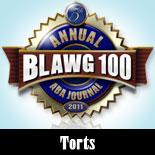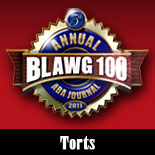We recently ran across a blog entry regarding the death of an asbestos/mesothieloma plaintiff whose lawyers and doctors contend that a 25-hour deposition sought by the defendants killed him. The blog quotes this disturbing L.A. Times column by Michael Hiltzik, entitled, “Mesothelioma victims deserve better than wasteful legal maneuvers.” Here’s the relevant portion of Hilztik’s piece:
Here’s the horrific question now: Did asbestos industry lawyers deliberately drive Johnson to his death by putting him through a brutal series of depositions so their clients would save money?
That’s what his family, his doctor and his lawyers assert. Despite affidavits from his doctor stating that 12 hours of depositions over a few weeks would be about as much as the 69-year-old’s health could stand, a Los Angeles Superior Court judge allowed the companies he was suing a total of 25 hours.
Johnson put off returning to the hospital so he could appear at every session, including the last, on Jan. 23. His face contorted in pain, he gasped out answers to questions from the last of the dozens of defense attorneys in attendance. Less than 40 minutes later, he collapsed.
The very next day he died at Hoag Memorial Hospital in Newport Beach. With him died his family’s claims for pain and suffering, mental anguish and bodily disfigurement, reducing their potential recovery in or out of court by as much as 70%, in the assessment of his attorney, Roger Worthington. What’s left are chiefly claims for medical bills and lost wages and for his wife’s loss of his companionship.
Johnson’s family, his lawyers, and his doctor have no doubt that the defense lawyers stretched out the legal process through what the family contends in court were “delay tactics and stalling,” in the expectation that he would die before he reached the finish line.
This is a very serious allegation, and the column in question, in suggesting that the conduct of the defense attorneys may have played a role in the death of the plaintiff, did not provide a full context of mesothieloma products liability cases and the litigation thereof. The column – which notes that California allows 20 hour depositions in asbestos cases – suggests that the default rules in federal court (7 hours) may have been more appropriate. However, the default rule is exactly that – a default – which can and should be modified when necessary. A civil case involving a single plaintiff, a single defendant, and a single trauma merits less discovery – and shorter depositions – than one in which a plaintiff’s entire career history must be explored in detail. To offer context, we must explore why asbestos depositions merit more time than those in other, simpler cases.
First and foremost, a typical asbestos plaintiff sues dozens and dozens and dozens of product manufacturers. (Hiltzik does note that the plaintiff in question initially sued 65 companies in his products liability suit, a number which was later reduced to 44 defendants). Sometimes, these plaintiffs also sue outside contractors who would have worked at plants where they, the plaintiffs, once worked. All of these defendants are different – – they are makers of entirely different products, and on many occasions, their products are similar enough to where questioning is needed to distinguish which products a plaintiff actually worked with or near. It goes without saying that each defendant in a case is entitled to explore the allegations against it in any lawsuit brought by a plaintiff. However, this task is made very difficult in asbestos cases because of the nature of the claims being made.
It is critical to note that asbestos plaintiffs often claim that they were exposed to asbestos over the course of a multi-decade career. It is not unusual for a plaintiff to allege that he was exposed to products over a 40 or 50 year career during the span of his life. (Hitzlik reports that the plaintiff worked “as a carpenter, auto mechanic and plumber from 1961 until 1990.”). Because each work site during a plaintiff’s career is the potential exposure site, those sites must be explored in detail. Further, because many of these plaintiffs typically worked at manufacturing or energy production plants, even if they worked for a single corporation during a long span of time, they often worked at many different plants and facilities owned and operated by their former employers, and each plant or facility may house or contain very different products. This information is critical to defendants because it may be that at a particular time at a particular location their products were unavailable or non-asbestos containing. Obviously, when there are 20 to 30 to 40 defendants, and each defendant has a different set of questions to ask about a different set of products, a deposition will be lengthy. First, the counsel taking lead on the deposition will survey the plaintiff’s entire career to determine where he alleges he was exposed to asbestos. That lead counsel will typically ask specific questions about the products his client manufacturers and leave to the other lawyers the task of asking about their own client’s products. Once the lead lawyer completes his examination, the other lawyers take their turn. Cutting off the deposition at seven hours would leave many lawyers without the opportunity to ask any questions whatsoever despite the fact that their clients have been sued.
So what are the potential remedies if a plaintiff is too ill to be deposed? Typically, the plaintiff himself is the only individual who can testify with some level of certainty as to where he worked and when. It’s hard to find witnesses who can testify about products used at a facility decades and decades ago. So, how would defense counsel learn that information if not directly from the plaintiff? Plaintiff’s counsel could alleviate this issue by being more specific in the complaint and discovery responses drafted on behalf of their clients. Unfortunately, many state court – and even federal court – complaints in asbestos cases simply list each defendant and then generally allege that at some point during the plaintiff’s career and/or life he was exposed to products manufactured by those defendants. The complaints rarely allege which products manufactured by those defendants the plaintiff worked with or near, nor do they generally list the specific time frames or locations where a particular defendant’s products are at issue. This leaves the defendants without much information to investigate the claims against it. Further, the plaintiff’s written discovery responses are typically unhelpful, as well. Again, written discovery may allege the type of product manufactured by a corporate defendant which the plaintiff worked with or near – a valve, a boiler, a gasket, a sealant, or something of that variety – but it still typically does not provide any more specific information than that (including the years that the plaintiff would have worked around that type of product). As another way to shorten the need for a lengthy deposition, plaintiff’s counsel could sue fewer defendants – perhaps they could sue the defendants whose products they know may have been at issue rather than those they simply suspect do.
It may be that the plaintiff does not know the particular model or brand of the products they worked with or near; but many asbestos plaintiffs’ firms have done a bit of research into these issues and typically represent clients who worked at the same locations. It seems as if plaintiff’s firms prosecuting mesothieloma asbestos cases either have to high a volume or to enumerate a specific products at issue or maintain a philosophy of suing everyone and then the defendants prove their way out. Either way, the only way that a defendant can learn whether its products were at issue is to ask the plaintiff directly.
So, as noted above, there are many, many reasons why asbestos depositions last longer than more traditional ones. Perhaps, Plaintiff’s counsel in these cases could provide a bit more information about the allegations in their complaints earlier in the process to obviate the need for extensive questioning, but if present trends continue, that certainly seems unlikely.
(Hat Tip: Max Kennerly).














